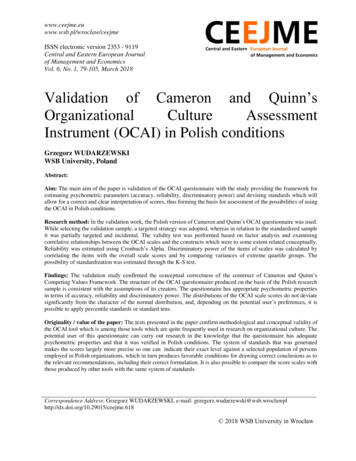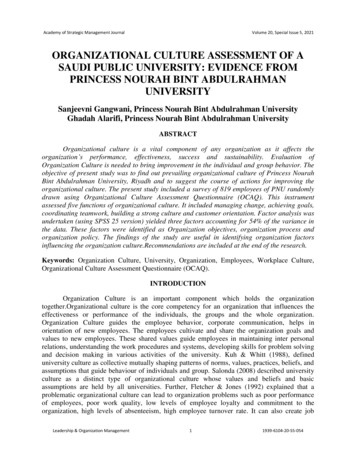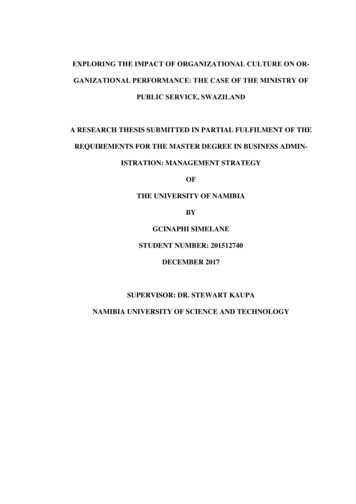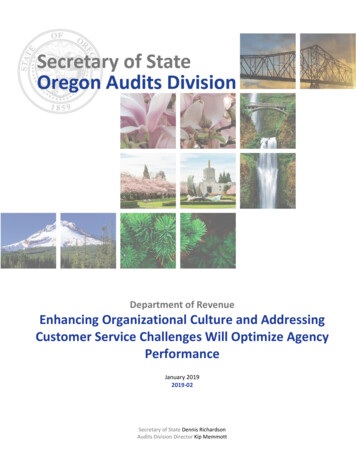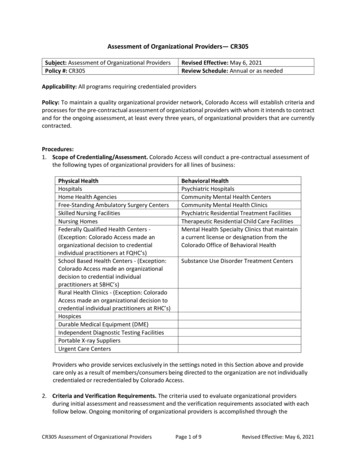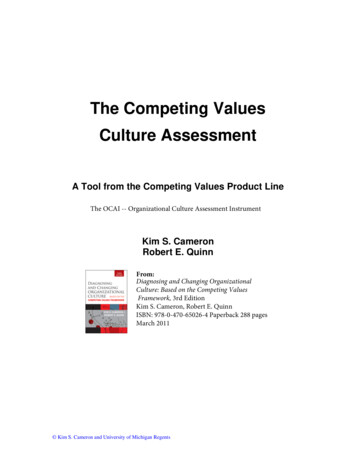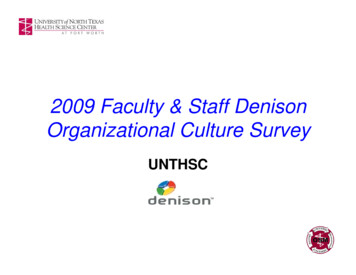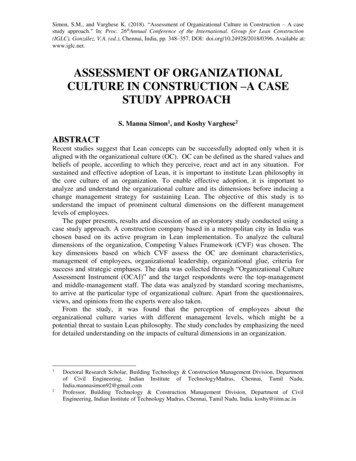
Transcription
Simon, S.M., and Varghese K. (2018). “Assessment of Organizational Culture in Construction – A casestudy approach.” In: Proc. 26thAnnual Conference of the International. Group for Lean Construction(IGLC), González, V.A. (ed.), Chennai, India, pp. 348–357. DOI: doi.org/10.24928/2018/0396. Available at:www.iglc.net.ASSESSMENT OF ORGANIZATIONALCULTURE IN CONSTRUCTION –A CASESTUDY APPROACHS. Manna Simon1, and Koshy Varghese2ABSTRACTRecent studies suggest that Lean concepts can be successfully adopted only when it isaligned with the organizational culture (OC). OC can be defined as the shared values andbeliefs of people, according to which they perceive, react and act in any situation. Forsustained and effective adoption of Lean, it is important to institute Lean philosophy inthe core culture of an organization. To enable effective adoption, it is important toanalyze and understand the organizational culture and its dimensions before inducing achange management strategy for sustaining Lean. The objective of this study is tounderstand the impact of prominent cultural dimensions on the different managementlevels of employees.The paper presents, results and discussion of an exploratory study conducted using acase study approach. A construction company based in a metropolitan city in India waschosen based on its active program in Lean implementation. To analyze the culturaldimensions of the organization, Competing Values Framework (CVF) was chosen. Thekey dimensions based on which CVF assess the OC are dominant characteristics,management of employees, organizational leadership, organizational glue, criteria forsuccess and strategic emphases. The data was collected through “Organizational CultureAssessment Instrument (OCAI)” and the target respondents were the top-managementand middle-management staff. The data was analyzed by standard scoring mechanisms,to arrive at the particular type of organizational culture. Apart from the questionnaires,views, and opinions from the experts were also taken.From the study, it was found that the perception of employees about theorganizational culture varies with different management levels, which might be apotential threat to sustain Lean philosophy. The study concludes by emphasizing the needfor detailed understanding on the impacts of cultural dimensions in an organization.12Doctoral Research Scholar, Building Technology & Construction Management Division, Departmentof Civil Engineering, Indian Institute of TechnologyMadras, Chennai, Tamil Nadu,India.mannasimon92@gmail.comProfessor, Building Technology & Construction Management Division, Department of CivilEngineering, Indian Institute of Technology Madras, Chennai, Tamil Nadu, India. koshy@iitm.ac.in
Assessment of Organizational Culture in Construction – A Case Study ApproachKEYWORDSChange Management, Commitment, Lean Construction, Lean Culture, OrganizationalCulture.INTRODUCTIONAfter the publication of the book “The Machine that Changed the World” in the 1990’s,the adoption of Lean practices, that was once confined to the automobile industryexpanded to other service sectors.(Matthias Holweg 2007). Many organizations aroundthe globe started to pilot Lean concepts in their projects. However, in the long run, mostof these organizations were not able to sustain Lean concepts, as most of them tried toimitate Lean tools and techniques rather than understanding that Lean is a culture-basedconcept.Lean concepts have percolated to the construction industry as “Lean Construction”.Many large-scale organizations and SME’s have tried adopting Lean Construction andhas succeeded to some extent. Coming to the Indian context, Lean Construction haspicked up in the recent years. Many large companies have tried and adopted LeanConstruction. However, in the long run, these organizations are not able to sustain LeanConstruction due to many reasons like hierarchical mind-set, cultural issues, lack of topmanagement support, lack of discipline, lack of inclusiveness etc. as mentioned in theliterature (Cano et al. 2015; Devaki and Jayanthi 2014; R. Jadhav et al. 2014). One of thekey reason mentioned in the literature is “Culture”. It can be seen that there is noalignment between the organizational culture and Lean culture. It is therefore importantto align these cultures for sustaining Lean.However, when we see the current state of the construction industry, aligningOrganizational culture with Lean culture seems to be a challenge due to the inherentculture of the sector. In addition to the uniqueness of construction projects, unskilled andchanging workforce, mindsets of the construction community and organizationalstructure disables the effective adoption of Lean construction. In this scenario, it is veryimportant to understand the organizational culture of the construction sector and mold itin such a way that Lean construction can sustain and yield long-term benefits.The overall objective of this paper is to assess the organizational culture andunderstand the impact of cultural parameters in enabling Lean.LITERATURE REVIEWThe literature review has been structured in three parts. The first part gives a briefintroduction to the organizational culture and different models for its assessment. Thesecond part briefly reviews Lean culture. The third part throws light on the existingliterature on organizational culture and Lean implementation and ends by identifying thegaps in the existing literature.ORGANIZATIONAL CULTUREThe term organizational culture has been defined in many ways by different managementscholars. One of the widely accepted definitions of organizational culture is given byPeople, Culture and Change349
S. Manna Simon and Koshy VargheseEdgar Schein. He defines Organizational culture as “a pattern of shared basicassumptions that the group has invented, discovered, or developed in learning to copewith its problem of external adaptation and internal integration and that have workedwell enough to be considered valid, and therefore, to be taught to new members as thecorrect way to perceive, think and feel in relation to those problems”. In simple terms,organizational culture can be defined as the sharedbeliefs of a group of people, accordingto which they perceive, act and react. Researchers have tried to classify organizationalculture through different methods and models. Some of the widely known models andmethods are described below: Hofstede dimensions of culture: Hofstede states that an organizational cultureand behavior is being influenced by the national and regional culture. Heidentified six dimensions of national culture which affects organizationalbehavior.Those six dimensions are: Power distance (extent to which less powerfulmembers of an organization believe and accept that power is distributedunequally), Uncertainty avoidance (extent to which members can accept or avertuncertainties), Individualism vs. collectivism (integration of members intogroups), Masculinity vs. femininity (extent to which members seek heroism,assertiveness or material reward instead of cooperation and quality of life), Longterm vs. short term orientation (determines focus) and Indulgence vs. Restraint (itis generally the measure of happiness/gratification of getting basic needs anddesires fulfilled) (Hofstede 2011; Zamanabadi 2017). Daniel Denison Model: Denison states that four dimension describesorganizational culture. Those four dimensions are Mission, Adaptability,Involvement, and Consistency. Missionincludes strategic direction, objectives,vision, and goals. Adaptability focuses on the customer, organizational learning,and creating a change. Involvement includes employee empowerment, skillbuilding, and team orientation. Consistency deals with the core values,coordination, and integration. (Denison and Neale 1999) Edgar Schein Model: Schein views an organizational culture as an observer andclassifies it into three: Artifacts, espoused values, and basic underlyingassumptions. Artifacts comprise of the visible part an organization that can beseen at the surface level of an organization like mission statements, slogans, dresscodes, rituals etc. Espoused values define the core values embedded in theorganizational member like norms. Basic underlying assumptions comprises ofelements that are not visible, nor spoken. These values exist within theorganizational members unconsciously and are taken-for-granted. (Schein 2004) Kim Cameron and Robert Quinn Model: Cameron and Quinn have proposed aframework which determines the organizational culture based on the flexibility,stability, external and internal focus of an organization. This model assesses thecharacteristics of an organization and distinguishes it into predefined cultural350 Proceedings IGLC-26, July 2018 Chennai, India
Assessment of Organizational Culture in Construction – A Case Study Approachgroups: Clan, Market Adhocracy, andHierarchical culture. (Cameron and Quinn2006)Apart from the mentioned models, there are several other models available such asGerry Johnson’s model, Stanley G. Harris model, Charles Handy model etc., that assessand classifies organizational culture. However, the central focus of this study remains onstrategy, dominant characteristics, organizational glue, management of employees,leadership style and criteria for success.LEAN CULTURELean can be defined as a management philosophy of continuous improvement whichconsists of a set of practices and processes. For effective adoption of Lean philosophy inan organization, it is very important to understand what is “Lean Culture”. Liker in hisbook titled “Toyota Culture” says that every Toyota plant has its own unique culture,based on its locality, leadership, history, and people. However, Toyota has developedcertain core principles that have to be followed by every Toyota plant regardless of thelocation. Toyota actually established its philosophy (Kaizen and respect for people) as thefoundation and built its core principle and strategy on it. Moreover, Toyota had methodsand tools to enable their principles and strategy in addition to the performancemeasurement and control systems. It is important to understand that Toyota is able tosustain its practices because the whole “Toyota Way” is established on its philosophy.Liker in his book “The Toyota Way” describes 14 management principles based on the4P model: Philosophy, Process, People & Partners, and Problem solving. The 4P modelemphasizes on adopting a long-term philosophy, process optimization, investing inpeople & partners and seeking consensus with the team members.The whole process of adopting Lean philosophy as the building stone of anorganization and aligning and sustaining the whole processes and people towards it, isdefined as Lean culture. It is very obvious to encounter a Lean failure if an organizationtries to imitate the visible Toyota Way. It is very important to understand that the visibleLean tools and practices are just the “Artifacts” which can be related to the tip of theiceberg and adopting these tools may yield some short-term benefits but in the long-run,it won’t yield. Therefore, it is important for an organization to assess its culture,understand its strength and weakness, and then adopt Lean principles in their BusinessExcellence Model.LEAN AND ORGANIZATIONAL CULTUREThis section of the literature review will try to explain: Why and how people resistchange? What can make people embrace change? What are the enablers of Lean adoption?How is organizational culture related and important for sustaining Lean?The literature on Lean implementation barriers states “Resistance to change” as acommon hindrance for Lean implementation across the service industries. (Cano et al.2015; Devaki and Jayanthi 2014; R. Jadhav et al. 2014; Salonitis and Tsinopoulos 2016;Shang and Sui Pheng 2014). Some of the reasons for resistance to change are: culture ofdistrust (when people are uncertain about the change process), Fear of unknown (lack ofPeople, Culture and Change351
S. Manna Simon and Koshy Vargheseclarity about the change process), personality conflicts (conflicts between the Lean expertand the employees), competing commitments, past negative experiences and violation ofpersonal compacts (personal compacts is the relationship between the employees and themanagement with regard to the mutual obligations and commitments (Strebel 2018)).People resist change by raising vocal opposition, false commitments, poor attitudes,deliberate failures and negative peer pressure. Although there are ways and means bywhich people resist change, there are certain enablers that can make people embracechange. These enablers are active and visible leadership by senior and middlemanagement, community-based leadership, employee initiative, providing reliableinformation, training for senior management, positive and strong relationships betweenworkers, employee empowerment and developing employees as an integral part of theorganization(Alkhoraif and McLaughlin 2016; Keyser et al. 2016). It can be seen thatthese enablers are strongly related to the organizational culture. The type of leadershipstyle, the involvement of people in the processes, developing and empowering people areall directly related to the culture of an organization. Few organizations may be able totake these types of initiatives for adopting Lean and few may find it difficult andcomplicated to cope up with these needed changes. Thus, it calls for an appropriatechange management strategy. To implement a change management strategy, it isimportant to understand, “what you are” and what you should be”. In other words, it isnecessary to assess and understand the current organizational culture and should be ableto fix a desired organizational culture. The journey from the current state to the desiredstate should be in incremental steps, analyzing the variations and improvement that takeplace in every step. There has been a study conducted in Brazil to find out the Ideal LeanCulture (Paro and Gerolamo 2017), which managers can use to benchmark the progressof their own journey. However, the study considered only the desired organizationalculture for sustaining Lean.This study will be focusing on understanding the current organizational culture in theconstruction sector in the Lean implementation context.RESEARCH METHODOLOGYThis research has employed an exploratory study to understand and assess theorganizational culture and the impact of its dimensions in Lean adoption. A large Indianconstruction company was chosen based on its active program in Lean implementation.Competing Values Framework (CVF) has been chosen to analyze the organizationalculture for this study. This frameworkutilizesOrganizational Culture AssessmentInstrument (OCAI) for collecting the data in the form of a questionnaire survey. Detailsof CVF and OCAI has been shared in the next section of this paper. The basic stepsinvolved in CVF are:a. Assessment of the current cultureb. Analysis of the current culturec. Setting and scoring the desired cultured. Analysing the desired culturee. Finding the difference between current vs. desired culture352 Proceedings IGLC-26, July 2018 Chennai, India
Assessment of Organizational Culture in Construction – A Case Study ApproachBut for this study, the desired culture was not assessed and evaluated. The current cultureof the organization was focussed. The questionnaire was distributed to 5 members of topmanagement, and 5 members of the middle level. All the employees were asked to scorethe statements in the scale of 100, for the six different dimensions (Dominantcharacteristics, Leadership, Organizational glue, management of employees, strategy,Criteria for success) as per the current culture. The score of the first, second, third andfourth statement of each six dimensions was added together to get the total score for Clan,Adhocracy, Market and Hierarchy Culture respectively. After getting the score for eachof the six dimensions, the average has been taken for these cultures.COMPETING VALUES FRAMEWORK (CVF)CVF is one of the most used and validated model for organizational culture assessment.CVF is a relevant model to understand, how the organization operates and the values thatcharacterize it. As organizational culture is complex, CVF uses two dimensions as shownin Fig 1. One dimension of CVF emphasizes flexibility and stability. The other dimensiondifferentiates an organization's internal focus with an external focus. These dimensionscreate four quadrants which define the values of an organization (Cameron and Quinn2006). OCAI assess organizational culture with six key dimensions which are describedbelow:a. Dominant Characteristics: It defines the level of teamwork, creativity, focus oncompetition & goals.b. Organizational Leadership: It defines leadership style.c. Management of Employees: It defines the level of participation, consensus etc.d. Organizational Glue: It defines cohesion between people.e. Strategic Emphases: It defines employee development, stability, goal setting etc.f. Criteria for Success: It is defined by how success is evaluated (market share, cost,etc.)People, Culture and Change353
S. Manna Simon and Koshy VargheseFig. 1: Competing Values FrameworkThe scores from the OCAI instrument will help to find out the current organizationalculture from the prominent cultures viz. Clan/Adhocracy/Market/Hierarchy culture. Theabove four organizational cultures are briefly explained below:a. Clan Culture: This organization has a friendly environment. Leaders are mentorsor can be called as facilitators. Groups show loyalty and are more traditional.Employee development and cohesion among the groups are given more priority.b. Hierarchy Culture: This organization is formal and highly structured. Employeebehavior is governed by rules, procedures, and standards. Leaders try to becomegood coordinators.c. Adhocracy Culture: This organization is highly dynamic, creative andentrepreneurial. People try to innovate and take risks. Freedom and initiatives areappreciated.d. Market Culture: This organization is focussed on execution. Employees tend to becompetitive & goal oriented. Success and reputation are of high priority.FINDINGSFrom the OCAI analysis, the CVF values are found to be: Clan Culture - 25 points,Adhocracy culture - 12 points, Market culture -17 points and Hierarchy culture - 26points. The resulting CVF model has been shown in Fig. 2.354 Proceedings IGLC-26, July 2018 Chennai, India
Assessment of Organizational Culture in Construction – A Case Study Approach121726MarketFigure 2: Current culture of the case organizationDISCUSSIONAs mentioned earlier, it is important to align Lean culture with the organizational culturein order to sustain effectiveness of Lean implementations. In a study conducted by Delhiet.al in Lean culture, reported that the behaviour of people changed once they realisedthat they are not under the direct watch of top management (Delhi et al. 2017). This typeof behaviour can be related to fat behaviour as mentioned by Emiliani (Emiliani 1998). Afat behaviour can be related to any behavioural action of a person that adds no value tothe processes. e.g.wasteful verbal content, confusion, negativity, ambiguity, deception,inaction etc. It is evident from the observation made by Delhi et.al that there are fewbehaviours in the employees which does not align with the Lean culture which can belinked to resistance of people to change. From the definition of organizational culture bySchein, it can be inferred that if this type of behaviour continues, it can become the normof the organization. However, fat behaviour is a threat in sustaining Lean philosophy. Inorder to have a basic understanding of the dynamics of an organizational culture, itsassessment at the current scenario is required.As already discussed in the earlier section, CVF has been used to assess theorganizational culture. The organizational culture dimensions considered in the CVFmodel are dominant characteristics, organizational leadership, management of employees,organizational glue, strategic emphases and criteria for success.People, Culture and Change355
S. Manna Simon and Koshy VargheseAs per the results obtained by the survey, it has been observed that the CVF values forhierarchical and clan culture is approximately equal. On further analysis, it is found thatthe perception and views of employees of different management levels are different. Topmanagement employees view the organizational culture as clan whereas the middlemanagement employees view it as hierarchical. The top management believesthat theorganization is more formal and collaborated, and the procedures and standards governthe working of the organization; whereas the employees of middle management levelperceive that the organization is more goal oriented and the leaders are demanding.Further analysis has been done with respect to the six dimensions of the CVF model,in order to understand the impact of these dimensions on the overall organizationalculture. The results of detailed investigation are explained below:Dominant characteristics: Weightage given to the organization for being a controlledand structured place, governed by formal procedures is very high, compared to theweightage given to the characteristics of clan culture. It is clear that this dimensionresembles the characteristics of a hierarchical culture.Organizational leadership: Weightage given for leadership to exemplify mentoring,facilitating or nurturing is almost equal to the weightage given to leadership thatcoordinates and organizes the smooth running. So, in this case, it is not possible todifferentiate if the organization exhibits the characteristics of clan or hierarchical culture.Management of employees: From the result, it can be clearly stated that themanagement style in the organization is characterized by team work, consensus andparticipation which resembles the characteristics of clan culture.Organizational glue, Strategic emphases, Criteria for Success: The weightages forthe characteristics of hierarchical and clan culture for this dimension are approximatelyequal to the each other. Thus, further investigation is needed to understand the impact ofthis parameter.It is not possible to draw any definitive conclusions in this study. The type oforganizational culture required for sustaining lean is not simplistic but a complexmultidimensional issue. But, the present study helps to understand that there are differentperceptions about organizational culture among the employees. It also highlights the needfor detailed research in the area to find the implications of various other culturaldimensions apart from the six dimensions of CVF.SUMMARY & FURTHER WORKThis study has adopted an exploratory research methodology to understand theorganizational culture in the construction sector with respect to Lean adoption. The studyhelped to understand that the perception of employees regarding the organizationalculture at different management levels varies, which is a potential threat to sustain Lean.The study is limited to a case with less number of respondents for the survey andinterviews. Further detailed investigation has to be done to understand the impact ofcultural dimensions on the organizational culture.356 Proceedings IGLC-26, July 2018 Chennai, India
Assessment of Organizational Culture in Construction – A Case Study ApproachACKNOWLEDGMENTThe authors would like to thank Mr. Yeshwanth Sainath, a Post-graduate student at IITMadras, for helping in data collection and would like to appreciate all the respondentsand experts for giving us their valuable time and expertise.REFERENCESAlkhoraif, A., and McLaughlin, P. (2016). “Organizational Culture that Inhibit the LeanImplementation.” (July), 39–58.Cameron, K. s., and Quinn, R. E. (2006). Diagnosing and Changing OrganizationalCulture.The Jossey-Bass Business & Management Series.Cano, S., Delgado, J., Botero, L., and Rubiano, O. (2015). “Barriers and Success Factorsin Lean Construction Implementation -Survey in Pilot Context.” (100), 631–641.Delhi, V. S. K., N, R., Mahalingam, A., and Varghese, K. (2017). “Initial Euphoria toSustained Change - Mainstreaming Lean Culture.” II(July), 267–274.Denison, D. R., and Neale, W. S. (1999). “Denison Organizational Culture Survey:Facilitator Guide.” Denison Consulting, LLC, 104.Devaki, M. P., and Jayanthi, R. (2014). “Barriers to Implementation of Lean Principlesin.” International Journal of Engineering Research & Technology, 3(5), 1189–1192.Emiliani, M. L. (1998). “Lean behaviors.” Management Decision, 36(9), 615–631.Hofstede, G. (2011). “Dimensionalizing Cultures: The Hofstede Model in Context.”Online Readings in Psychology and Culture, 2(1), 1–26.Keyser, R. S., Sawhney, R. S., and Marella, L. (2016). “A management framework forunderstanding change in a lean environment.” Tékhne, Instituto Politécnico doCávado e do Ave (IPCA), 14(1), 31–44.Matthias Holweg. (2007). “The genealogy of lean production.” Journal of OperationsManagement, 25, 420–437.Paro, P. E. P., and Gerolamo, M. C. (2017). “Organizational culture for lean programs.”Journal of Organizational Change Management, 30(4), 584–598.R. Jadhav, J., S. Mantha, S., and B. Rane, S. (2014). “Exploring barriers in leanimplementation.” International Journal of Lean Six Sigma, 5(2), 122–148.Salonitis, K., and Tsinopoulos, C. (2016). “Drivers and Barriers of Lean Implementationin the Greek Manufacturing Sector.” Procedia CIRP, The Author(s), 57(December),189–194.Schein, E. H. (2004). “Organizational Culture and Leadership.” Leadership, 7, 437.Shang, G., and Sui Pheng, L. (2014). “Barriers to lean implementation in the constructionindustry in China.” Journal of Technology Management in China, 9(2), 155–173.Strebel, P. (2018). “Why do Employees Resist Change?” Harvard Business Review,(May-June 1996), 1–13.Zamanabadi, K. I. (2017). “Hofstede â TM S Cultural Dimensions and NationalInnovation Level.” 3(1), 45–49.People, Culture and Change357
success and strategic emphases. The data was collected through "Organizational Culture Assessment Instrument (OCAI)" and the target respondents were the top-management and middle-management staff. The data was analyzed by standard scoring mechanisms, to arrive at the particular type of organizational culture. Apart from the questionnaires,



